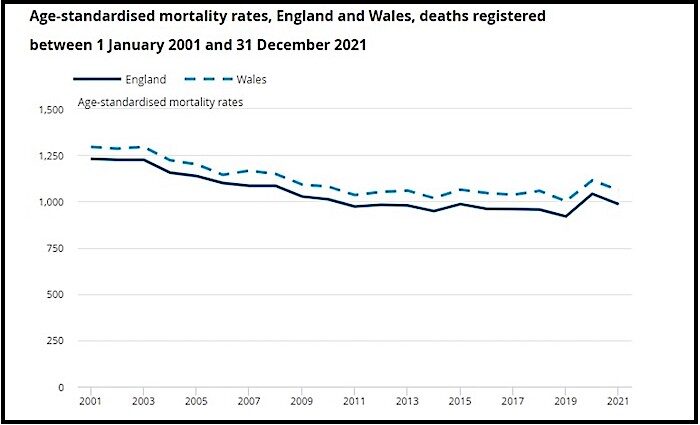
© unknown
Many lockdown sceptics have recently been sharing
statistics from the ONS showing that
just 17,371 people died of Covid in England and Wales up to the end of September 2021 where COVID-19 was the only cause of death recorded on the death certificate. This compares to
148,536 official Covid deaths in the same period (also for England and Wales, as are the estimates below)
where COVID-19 was mentioned as a cause of death somewhere on the death certificate. Separately, the Government dashboard reported 126,384 deaths recorded as occurring within 28 days of a positive Covid test in the same period,
while the ONS reported 117,247 excess deaths.
A more recent response to a Freedom of Information request in January
gives a figure of just 6,183 deaths, again where COVID-19 was the only cause mentioned on the death certificate, this time up to December 31st 2021. The reason for the difference in these two figures is likely to relate to
the definition used - the first figure (17,371) came from a
dataset on pre-existing conditions that has been published throughout the pandemic (so didn't actually need an FOI request to provide the data) and the definition is stated in the dataset. The definition and source of the second figure (6,183) is
not stated.
Either way, the figures are an order of magnitude lower than official Covid deaths - for example, 17,371 is just 12% of the official ONS tally of Covid deaths of 148,536 - and some sceptics have inferred from this that
up to 90% of the official Covid deaths are not really Covid deaths, or at least were likely to have happened around that time anyway, and thus that the pandemic death toll has been hugely overstated.
Now, it's true that the pandemic death toll has been overstated. For example, in the most recent week, the
ONS itself explains that of the official Covid deaths which mention COVID-19 somewhere on the death certificate,
22.8% were recorded as of a different underlying cause. Over the whole pandemic up to December 31st 2021, 141,057 of 156,924 or 90% of Covid deaths were
registered with Covid as the underlying cause, leaving 10% as of a different underlying cause. That's the official estimate of the overstatement, with others putting it higher.
However, to conclude from this that the other 70-80% of Covid deaths - the ones where Covid was recorded as the underlying cause alongside other contributory causes - were not really due to Covid or would have happened anyway is assuming too much.
The important question is whether a death would have happened anyway in the absence of the underlying cause. In most cases the answer is no, which is why it's been recorded as the underlying cause. Yes, a person may have several comorbidities, which are the reason Covid proved deadly for him; without those, he may well have survived Covid. However, crucially, without Covid he may well not have died at that point, as Covid was the underlying cause of his death.
How can we know one way or the other? It's frequently noted that
the most reliable measure of the true impact of the pandemic is excess or above-average mortality, as that is not affected by slippery definitions of Covid deaths. One drawback is
it is confounded by 'lockdown' deaths, i.e., deaths resulting from interventions and the public response, such as lack of access to healthcare. However, as excess deaths declined at the same time as reported infections in early 2021 despite the drawn-out lockdown (see chart above) it seems safe to conclude that a sizeable majority of excess deaths classified as due to Covid (underlying cause) were indeed caused by Covid and would not have happened at that point in its absence.
This means that 117,247 (up to the end of September 2021) seems a reasonable approximation of the number of people who died due to COVID-19 who would have survived for some time otherwise.This figure need to be put into perspective, as
over half a million people die each year in England and Wales, pandemic or no pandemic, and the average age of death with Covid is higher than the average age of death from all causes, meaning most of those who die were coming towards the end of their lives in any case. Indeed, once the aging of the population has been taken into account,
2020 was only the most deadly year since 2008, while according to
new data released by the ONS this month,
2021 was only the most deadly year since 2015 (see chart at top). So it's hardly worth upending lives, demolishing cherished liberties and causing widespread suffering and loss over - particularly as there's
scant evidence restrictions, which can at best only delay infection, have saved lives.
Reader Comments
to our Newsletter